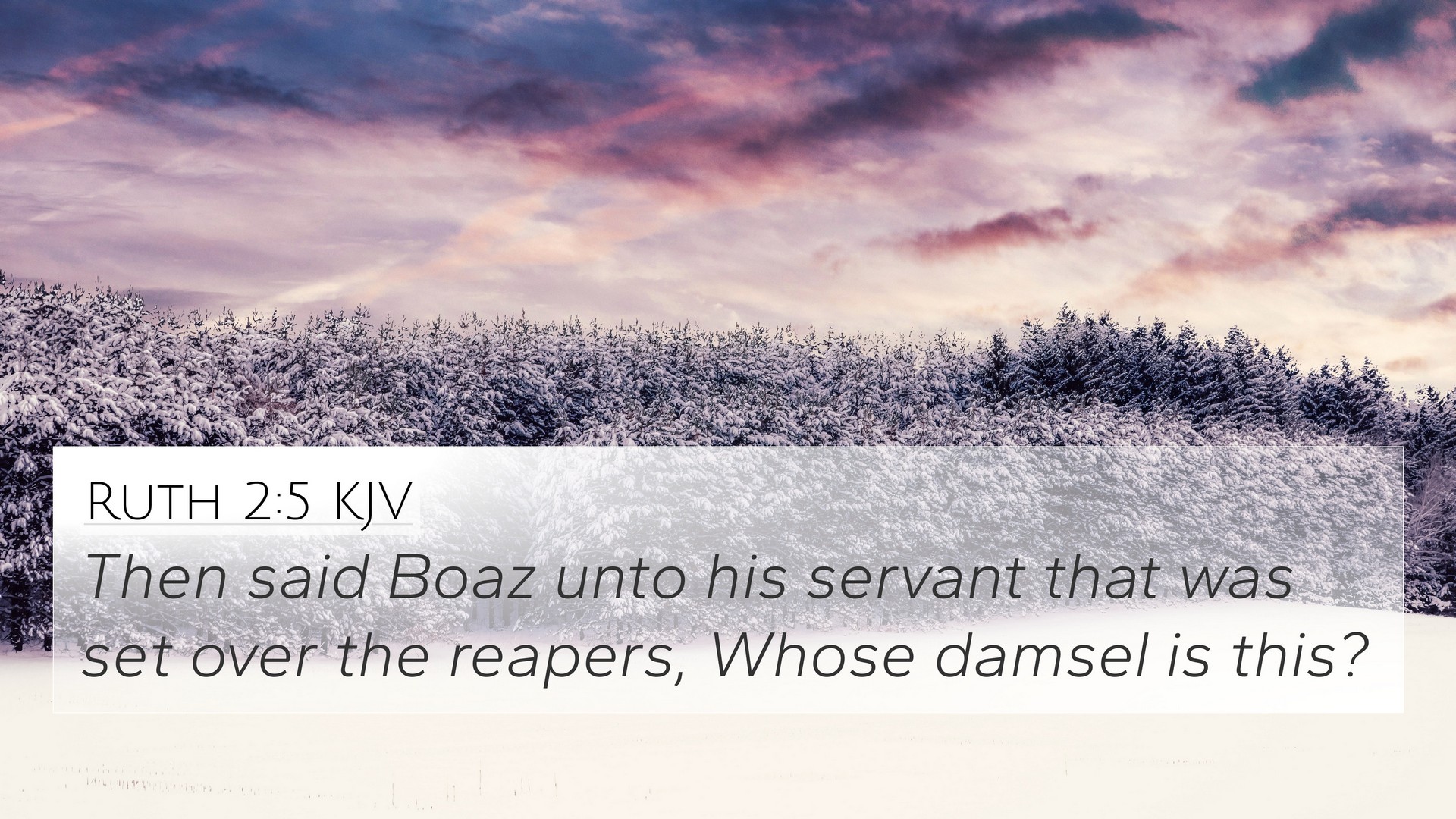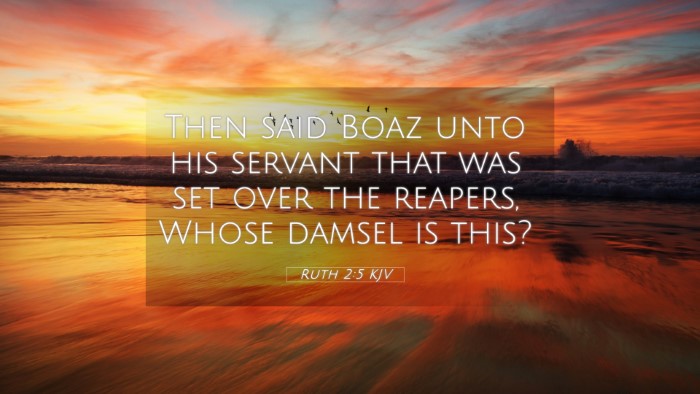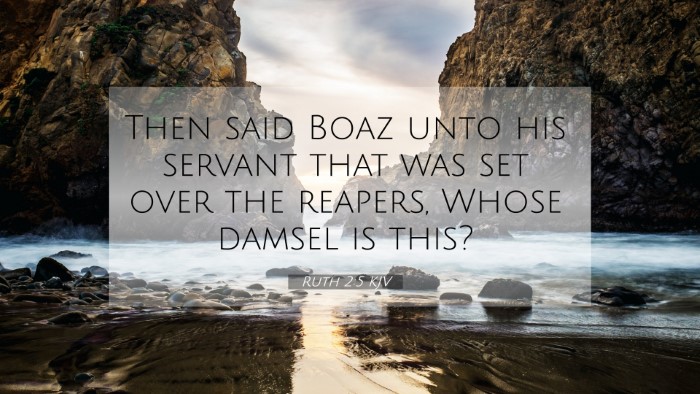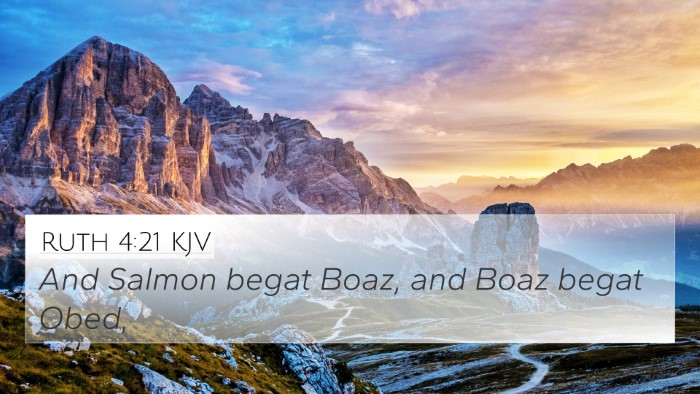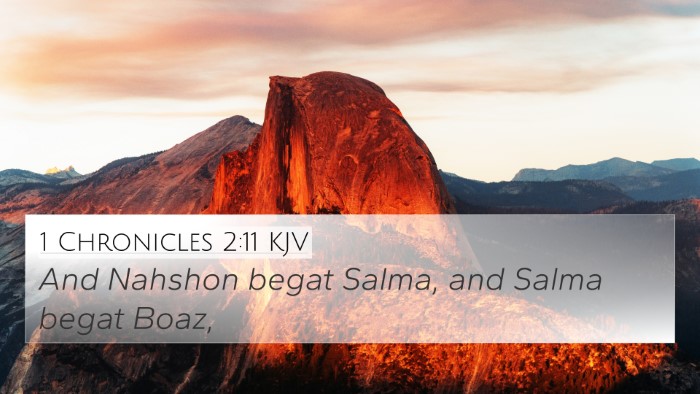Old Testament
Genesis Exodus Leviticus Numbers Deuteronomy Joshua Judges Ruth 1 Samuel 2 Samuel 1 Kings 2 Kings 1 Chronicles 2 Chronicles Ezra Nehemiah Esther Job Psalms Proverbs Ecclesiastes Song of Solomon Isaiah Jeremiah Lamentations Ezekiel Daniel Hosea Joel Amos Obadiah Jonah Micah Nahum Habakkuk Zephaniah Haggai Zechariah MalachiRuth 2:5 Similar Verses
Ruth 2:5 Cross References
Then said Boaz unto his servant that was set over the reapers, Whose damsel is this?
Uncover the Rich Themes and Topics of This Bible Verse
Listed below are the Bible themes associated with Ruth 2:5. We invite you to explore each theme to gain deeper insights into the Scriptures.
Ruth 2:5 Cross Reference Verses
This section features a detailed cross-reference designed to enrich your understanding of the Scriptures. Below, you will find carefully selected verses that echo the themes and teachings related to Ruth 2:5 KJV. Click on any image to explore detailed analyses of related Bible verses and uncover deeper theological insights.
Ruth 2:5 Verse Analysis and Similar Verses
Understanding Ruth 2:5
Ruth 2:5 states: "Then said Boaz unto his servant that was set over the reapers, Whose damsel is this?" This verse is pivotal in the narrative of Ruth, highlighting key themes of divine providence, social dynamics, and the unfolding story of redemption.
Verse Meaning and Context
This verse introduces Boaz, a wealthy landowner, inquiring about Ruth, a Moabite woman gleaning in his fields. His question signifies attention and curiosity about her background. Several important themes can be drawn from this inquiry.
Key Themes in Ruth 2:5
- Providential Timing: This moment marks the intersection of Ruth's fate with Boaz, highlighting God's orchestrated timing in the life of those who seek refuge in Him.
- Identity and Recognition: Boaz's question emphasizes the significance of one’s identity. Ruth, a foreigner, is now recognized within Israelite society.
- Social and Cultural Dynamics: The question reflects the customs of the time, where gleaning was a means for the poor and marginalized to survive, and it showcases the societal roles in Israel.
- Foreshadowing Redemption: Boaz’s interest in Ruth foreshadows the redemptive acts he will soon perform, establishing him as a kinsman-redeemer.
Insights from Commentaries
The following insights summarize thoughts from prominent public domain commentaries:
Matthew Henry's Commentary
Matthew Henry points out how Boaz’s question reflects a godly curiosity. He identifies Ruth’s humility and hard work, which Boaz notices, suggesting that good character attracts goodwill and favor.
Albert Barnes' Notes
Barnes emphasizes that Boaz's inquiry goes beyond mere interest; it demonstrates his awareness of the social dynamics at play. Ruth's actions not only highlight her virtue but also signal her significant role in the lineage of David.
Adam Clarke's Commentary
Clarke explains the socio-cultural implications of Ruth's gleaning in Boaz’s field, indicating it is a notable intersection of providence. He highlights Boaz's character, showing how leaders should not only inquire about laborers but also recognize their backgrounds.
Cross-References and Biblical Connections
Ruth 2:5 has multiple connections with other Bible verses that deepen the understanding of its themes:
- Leviticus 19:9-10: Discusses the law of gleaning, showing the foundation for Ruth's actions.
- Deuteronomy 24:19: Provides insight into the regulations that allowed the poor to glean the fields.
- Matthew 1:5: Indicates Ruth’s significance in the genealogy of Jesus, connecting her story to salvation history.
- Galatians 3:28: Highlights the inclusivity found in Christ, paralleling Ruth’s acceptance into the Israelite community.
- Isaiah 56:3-7: Speaks to the inclusion of foreigners in God’s community, resonating with Ruth’s circumstances.
- 1 Timothy 5:8: Relates to the importance of providing for one’s family, reflecting Boaz’s protective and benevolent character towards Ruth.
- Philippians 4:19: Affirms God’s provision for those who trust Him, paralleling Ruth's reliance on divine care.
Thematic Bible Verse Connections
When studying Ruth 2:5, one can see thematic connections with verses focused on provision, identity, and redemption:
- Psalm 146:7: God’s care for the needy and oppressed, similar to Ruth’s plight.
- James 1:27: A call to look after orphans and widows, paralleling Ruth's status as a widow.
Conclusion
Ruth 2:5 serves as a significant moment in the story that encapsulates providence, identity, and a preview of redemption. By examining this verse and its connections through a variety of biblical texts, one uncovers rich layers of meaning that highlight God’s faithfulness to His people. For further study, consider tools like a Bible concordance or a cross-reference Bible study guide to explore more intricate relationships and utterances found throughout scripture.
